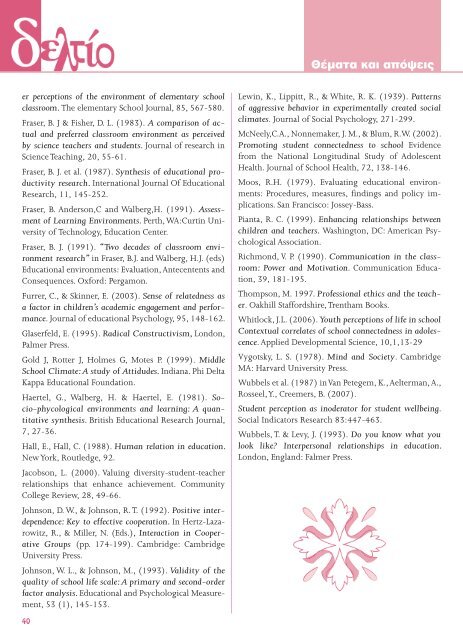deltio54
deltio54
deltio54
Create successful ePaper yourself
Turn your PDF publications into a flip-book with our unique Google optimized e-Paper software.
Θέματα και απόψειςer perceptions of the environment of elementary schoolclassroom. The elementary School Journal, 85, 567-580.Fraser, B. J & Fisher, D. L. (1983). A comparison of actualand preferred classroom environment as perceivedby science teachers and students. Journal of research inScience Teaching, 20, 55-61.Fraser, B. J. et al. (1987). Synthesis of educational productivityresearch. International Journal Of EducationalResearch, 11, 145-252.Fraser, B. Anderson,C and Walberg,H. (1991). Assessmentof Learning Environments. Perth, WA:Curtin Universityof Technology, Education Center.Fraser, B. J. (1991). “Two decades of classroom environmentresearch” in Fraser, B.J. and Walberg, H.J. (eds)Educational environments: Evaluation, Antecentents andConsequences. Oxford: Pergamon.Furrer, C., & Skinner, E. (2003). Sense of relatedness asa factor in children’s academic engagement and performance.Journal of educational Psychology, 95, 148-162.Glaserfeld, E. (1995). Radical Constructivism, London,Palmer Press.Gold J, Rotter J, Holmes G, Motes P. (1999). MiddleSchool Climate: A study of Attidudes. Indiana. Phi DeltaKappa Educational Foundation.Haertel, G., Walberg, H. & Haertel, E. (1981). Socio-phycologicalenvironments and learning: A quantitativesynthesis. British Educational Research Journal,7, 27-36.Hall, E., Hall, C. (1988). Human relation in education.New York, Routledge, 92.Jacobson, L. (2000). Valuing diversity-student-teacherrelationships that enhance achievement. CommunityCollege Review, 28, 49-66.Johnson, D. W., & Johnson, R. T. (1992). Positive interdependence:Key to effective cooperation. In Hertz-Lazarowitz,R., & Miller, N. (Eds.), Interaction in CooperativeGroups (pp. 174-199). Cambridge: CambridgeUniversity Press.Johnson, W. L., & Johnson, M., (1993). Validity of thequality of school life scale: A primary and second-orderfactor analysis. Educational and Psychological Measurement,53 (1), 145-153.Lewin, K., Lippitt, R., & White, R. K. (1939). Patternsof aggressive behavior in experimentally created socialclimates. Journal of Social Psychology, 271-299.McNeely,C.A., Nonnemaker, J. M., & Blum, R.W. (2002).Promoting student connectedness to school Evidencefrom the National Longitudinal Study of AdolescentHealth. Journal of School Health, 72, 138-146.Moos, R.H. (1979). Evaluating educational environments:Procedures, measures, findings and policy implications.San Francisco: Jossey-Bass.Pianta, R. C. (1999). Enhancing relationships betweenchildren and teachers. Washington, DC: American PsychologicalAssociation.Richmond, V. P. (1990). Communication in the classroom:Power and Motivation. Communication Education,39, 181-195.Thompson, M. 1997. Professional ethics and the teacher.Oakhill Staffordshire, Trentham Books.Whitlock, J.L. (2006). Youth perceptions of life in schoolContextual correlates of school connectedness in adolescence.Applied Developmental Science, 10,1,13-29Vygotsky, L. S. (1978). Mind and Society. CambridgeMA: Harvard University Press.Wubbels et al. (1987) in Van Petegem, K., Aelterman, A.,Rosseel, Y., Creemers, B. (2007).Student perception as inoderator for student wellbeing.Social Indicators Research 83:447-463.Wubbels, T. & Levy, J. (1993). Do you know what youlook like? Interpersonal relationships in education.London, England: Falmer Press.40


